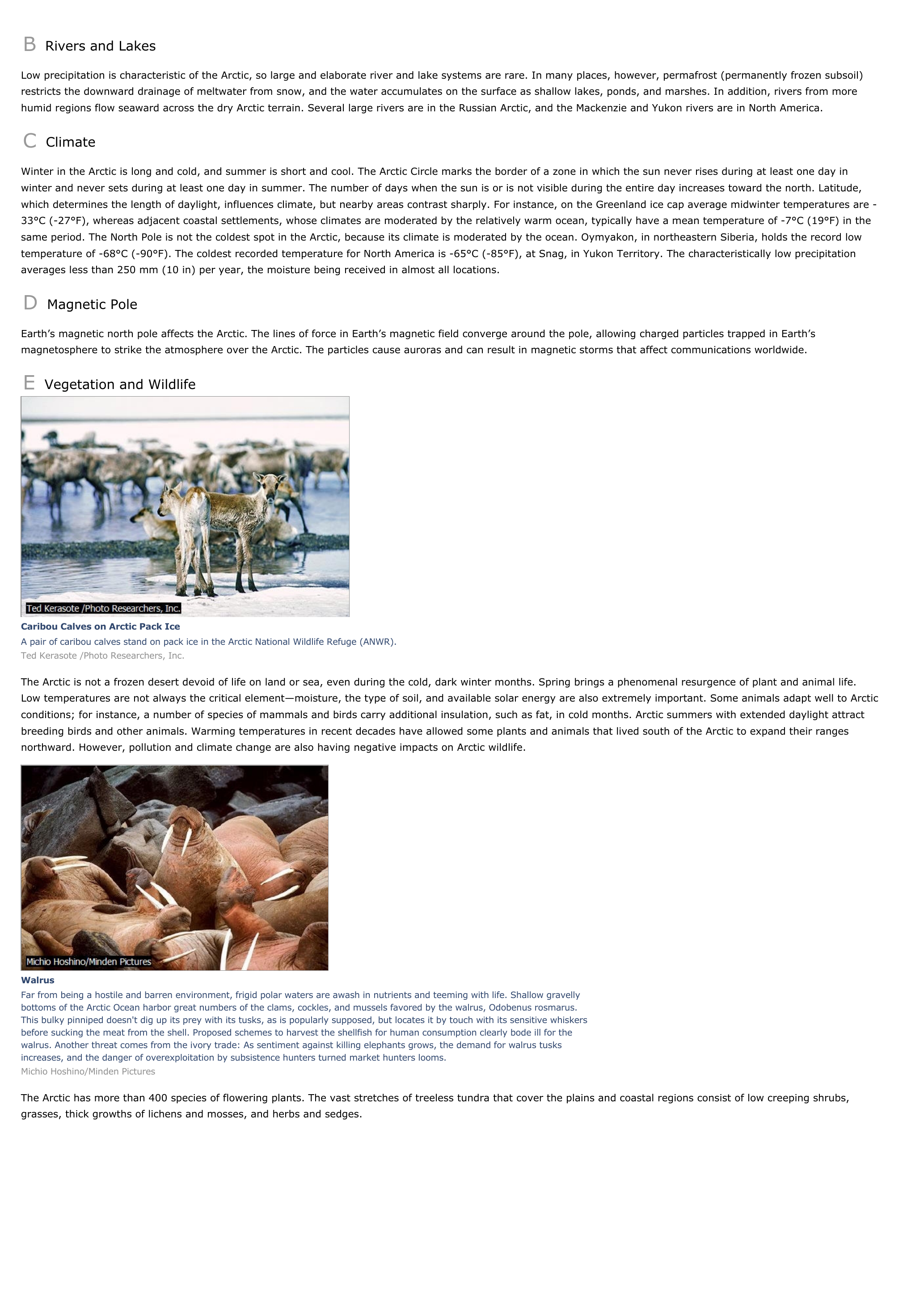Arctic - geography.
Publié le 26/05/2013

Extrait du document
«
B Rivers and Lakes
Low precipitation is characteristic of the Arctic, so large and elaborate river and lake systems are rare.
In many places, however, permafrost (permanently frozen subsoil)restricts the downward drainage of meltwater from snow, and the water accumulates on the surface as shallow lakes, ponds, and marshes.
In addition, rivers from morehumid regions flow seaward across the dry Arctic terrain.
Several large rivers are in the Russian Arctic, and the Mackenzie and Yukon rivers are in North America.
C Climate
Winter in the Arctic is long and cold, and summer is short and cool.
The Arctic Circle marks the border of a zone in which the sun never rises during at least one day inwinter and never sets during at least one day in summer.
The number of days when the sun is or is not visible during the entire day increases toward the north.
Latitude,which determines the length of daylight, influences climate, but nearby areas contrast sharply.
For instance, on the Greenland ice cap average midwinter temperatures are -33°C (-27°F), whereas adjacent coastal settlements, whose climates are moderated by the relatively warm ocean, typically have a mean temperature of -7°C (19°F) in thesame period.
The North Pole is not the coldest spot in the Arctic, because its climate is moderated by the ocean.
Oymyakon, in northeastern Siberia, holds the record lowtemperature of -68°C (-90°F).
The coldest recorded temperature for North America is -65°C (-85°F), at Snag, in Yukon Territory.
The characteristically low precipitationaverages less than 250 mm (10 in) per year, the moisture being received in almost all locations.
D Magnetic Pole
Earth’s magnetic north pole affects the Arctic.
The lines of force in Earth’s magnetic field converge around the pole, allowing charged particles trapped in Earth’smagnetosphere to strike the atmosphere over the Arctic.
The particles cause auroras and can result in magnetic storms that affect communications worldwide.
E Vegetation and Wildlife
Caribou Calves on Arctic Pack IceA pair of caribou calves stand on pack ice in the Arctic National Wildlife Refuge (ANWR).Ted Kerasote /Photo Researchers, Inc.
The Arctic is not a frozen desert devoid of life on land or sea, even during the cold, dark winter months.
Spring brings a phenomenal resurgence of plant and animal life.Low temperatures are not always the critical element—moisture, the type of soil, and available solar energy are also extremely important.
Some animals adapt well to Arcticconditions; for instance, a number of species of mammals and birds carry additional insulation, such as fat, in cold months.
Arctic summers with extended daylight attractbreeding birds and other animals.
Warming temperatures in recent decades have allowed some plants and animals that lived south of the Arctic to expand their rangesnorthward.
However, pollution and climate change are also having negative impacts on Arctic wildlife.
WalrusFar from being a hostile and barren environment, frigid polar waters are awash in nutrients and teeming with life.
Shallow gravellybottoms of the Arctic Ocean harbor great numbers of the clams, cockles, and mussels favored by the walrus, Odobenus rosmarus.This bulky pinniped doesn't dig up its prey with its tusks, as is popularly supposed, but locates it by touch with its sensitive whiskersbefore sucking the meat from the shell.
Proposed schemes to harvest the shellfish for human consumption clearly bode ill for thewalrus.
Another threat comes from the ivory trade: As sentiment against killing elephants grows, the demand for walrus tusksincreases, and the danger of overexploitation by subsistence hunters turned market hunters looms.Michio Hoshino/Minden Pictures
The Arctic has more than 400 species of flowering plants.
The vast stretches of treeless tundra that cover the plains and coastal regions consist of low creeping shrubs,grasses, thick growths of lichens and mosses, and herbs and sedges..
»
↓↓↓ APERÇU DU DOCUMENT ↓↓↓
Liens utiles
- Arctic - Geography.
- Arctic Ocean - Geography.
- Arctic Summer Rain - geography.
- Arctic Ocean - geography.
- Tokyo - geography.

































